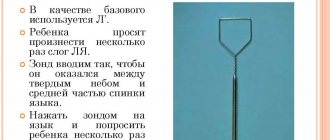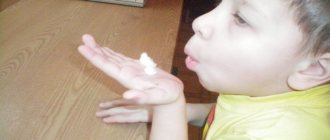Reasons for incorrect pronunciation
Incorrect pronunciation of hissing and whistling sounds is called sigmatism.
The reasons why it may appear are various. The most common ones are the following:
- Features of the structure of the articulatory apparatus: shortened frenulum, “Gothic” palate (when the child has a high arch of the hard palate), structural defects of the jaw (bad bite), nasopharynx.
- Weak innervation of the tongue muscles, or, on the contrary, high muscle tone.
- Impaired phonemic awareness.
- Delay in the development of the child’s nervous system.
Problems with sound pronunciation can also appear against the background of imitating the incorrect speech of an adult. It is important that the child hears correct, clear speech not only in lessons with specialists, but also at home.
Techniques for practicing the sound “Zh” with children
Work to correct a child’s erroneous pronunciation of the sound “Zh” should take place in several stages:
- Observing his pronunciation and searching for the source of the defect.
- Choosing a working method.
- Practicing correct pronunciation.
- Automation of acquired skills.
Observation process
The first step in working with incorrect speech should always be observing the child’s pronunciation. It is very important to determine what is the reason for the incorrect sound of “F”. There are several variants of its erroneous pronunciation:
- swallowing the sound “Zh”;
- replacement with “B” - labiodental parasigmatism;
- pronunciation "G" - nasal sigmatism;
- “D” instead of “F” - paradental parasigmatism;
- replacement with “Ш” or “З” - hissing and whistling parasigmatism.
The parent should monitor the baby’s articulation and breathing when pronouncing the sound. Once the cause is determined, it is much easier to correct the defect. So, for example, replacement with other sounds is most often a consequence of incorrect articulation - which means, first of all, the emphasis should be on its correction.
Sometimes the child directs the air stream incorrectly - this can be seen by puffy cheeks or a weak air flow - then in addition to the articulatory component, breathing exercises must be included.
If your baby is unable to reproduce sonority, you need to train your vocal cords.
Articulatory position of the sound Ж
The articulation of the sound Ж is similar to the position of the sound Ш, but with the only difference - in the first case it is necessary to pronounce with the addition of a voice (the ligaments are tense), otherwise the characteristics are the same:
- The lips are slightly forward, rounded, as when producing the sound O.
- The back of the tongue is raised towards the back of the upper palate.
- The tip of the tongue is directed upward towards the alveoli, located behind the front teeth.
- The side of the tongue rests on both sides of the molars.
Staging F
To pronounce the sound Zh, correct articulation is important. The lips, tongue, hard and soft palates, and vocal cords are involved in the creation of sound:
- The lips are rounded, the mouth is not opened too wide, the teeth are located at a short distance from each other.
- The tongue is wide, raised to the edge of the hard palate (right behind the upper teeth). Its middle part is lowered, and the sides are raised and pressed firmly against the teeth.
- The back of the back of the tongue is raised and pulled back. A strong directed air stream passes between it and the sky. The soft palate is raised, blocking the passage into the nasopharynx.
- The vocal cords vibrate.
Speech therapy profile of sound F
Incorrect pronunciation of sound: types of sibilant sigmatism
Sometimes parents of a child who has problems with sound pronunciation turn to a speech therapist late for help. Or they even think that the baby has no problems with speech, due to the fact that they do not always know how this or that sound should be reproduced correctly. Each sound has its own articulatory position. By ear, it may seem that the child seems to pronounce it (doesn’t miss it or replace it, just “F” is heard), but at the same time he doesn’t always articulate it correctly.
The work is carried out individually, depending on the characteristics of the violation. There are several types of hissing sigmatism, characterized by incorrect position of the organs of the speech apparatus:
- Lower (the sound is softened).
- Rear-lingual (in this case, the position of the articulatory organs is as with the sounds G, X; this leads to the fact that the sound Z is pronounced noisily).
- Buccal (in this case, the tongue is motionless, the cheeks are puffed out, the teeth are closed, and a dull, booming sound is formed).
Setting the sound
With normal speech development, “hissing” sounds, which include [Ш], [Ж], [Ч], [Ш], should appear in the child’s speech by the age of 4-4.5 years.
[Zh] is a consonant, always hard, sonorous sound of the Russian language.
There are several ways to achieve the result:
- With mechanical assistance
- By showing articulation
- From correct [R]
The use of one or more methods in combination depends on each specific situation.
To solve our problem, it is necessary to perform an appropriate set of articulation and breathing exercises every day.
Don't miss: The simplest and most effective ways to make the sound R and Rb
Breathing exercises
- "Swing". Take a lying position on your back. One hand is on the stomach and the other on the chest. When you inhale through your nose, your stomach rises; when you exhale through your mouth, your stomach lowers.
Exercise "Swing"
- "Bullets." Fill any small container (mug, glass, small jug) with clean water. Take a cocktail straw. Through it you need to exhale air into the water. Bubbles bursting out with a loud noise will turn the execution into an exciting game.
- "Singing". The vowels [A], [O], [U], [Y] must be sung when answering the question asked. How do the animals moan that came to Dr. Aibolit? "O-O-O-O-O." How does a snow blizzard howl in winter? “U-U-U-U-U-U.” How does the train hum when it sets off? “Y-Y-Y-Y-Y.” How naughty is a baby? "A-A-A-A-A." These chants must be pronounced as long as possible, but with one exhalation.
Articulation gymnastics exercises
- "Fence". Without opening your teeth, smile broadly. Do not strain your facial muscles. Try to hold a smile for 10-15 seconds.
- "Tube". Closed teeth are the main condition. Invite the child to reach out and take a nearby berry with his lips. If performed correctly and repeatedly, the lips will form a “tube”.
- "Broad language" The lips are open, we stick our tongue out of the mouth, and spank it with our lips several times until it becomes wide. We hold it in this position for 10-15 seconds. We calculate the time out loud.
Exercise "Scapula"
- "Shovel". The task is a continuation of the previous one. We place a wide, calm tongue, which we have already learned how to do, on the lower lip. The facial muscles are as relaxed as possible. Hold for 10-15 seconds.
- "Ball Throw" Make a small ball from a piece of cotton wool. Position the tongue as in the “Shovel” exercise. Bring your face closer to the ball and blow on it, trying to “throw” it as far as possible. When performing the task correctly, a distinct [F] should be heard.
- "Nitting." Open your mouth slightly. Slowly stick out your tongue and slowly bite it. Repeat the process several times, sticking your tongue forward and retracting it back. Perform with a smile, tensing your muscles. By saying something rhythmic, the child not only makes the task easier, but also becomes interested in it.
- "Cup". Open your lips and stick your tongue out. Try to bend it into the shape of a cup. It is recommended to perform in front of a mirror.
Don't miss: What is ZPRR and how to correct it?
- "Ladder". A more complex version of "Cup". We stick out our tongue and give it the appropriate shape. Raise it to your upper lip and hold it for a few seconds. We transfer to the upper teeth. We hold again. We translate, as if on a “ladder,” for them. We hold. We perform the process in reverse order. We repeat several such descents and ascents.
- "We got dirty with ice cream." Without helping with the lower lip, but only with one tongue, lick the upper lip with a vertical movement (from the nose down). The child must imagine that she has soiled herself with something tasty. For example, ice cream.
- “Brushing our teeth.” We smile and open our mouth wide. The teeth should be clearly visible. We begin to move the tip of the tongue from the inside, first along the upper teeth several times, then along the lower ones. The movements should resemble those of a toothbrush. Try not to move your lower jaw.
Exercise “Brushing your teeth”
- "Ball on the nose." Let's prepare a small ball of cotton wool. We open our mouth slightly. We lightly press the protruding tip of the tongue to the upper lip. By blowing air between your tongue and lip, we try to blow the ball off your nose. The flow should be directed upward.
- "Let's draw." We open our mouth wide, trying to smile. We begin to slowly stroke the palate with the tip of our tongue. The movements should resemble an artist's brush.
- "Mushroom leg" Open your mouth wide. We stick our tongue to the palate. The hypoglossal ligament stretches like a mushroom stalk. Hold this way for several seconds.
- "Umbrella". Let's complicate the previous exercise. Holding your tongue, we close and open your lips, as if opening an umbrella. We repeat several times, trying to open our “umbrella” as wide as possible. The exercise is aimed at stretching the hypoglossal ligament.
- "Buzzing." "Cup" of the tongue inside the mouth. Pull the lips forward a little and round them. The tip of the tongue is to the palate, the edges are pressed against the upper lateral teeth. When trying to pronounce a buzz, the throat begins to tremble.
Speech material for sound automation
Syllables (example):
We take individual syllables - zha, zho, zhe, zhi, zhu. We pronounce them separately several times, as clearly as possible. We make a design of two - zha-zhu, zhu-zhe, zhu-zhu and others. We pronounce it. We complicate it to three - zha-zho-zha, zhu-zho-zha, zhu-zhi-zha.
Don't miss: What is dysgraphia?
The exercise is not about speed, but about clear pronunciation.
Words (example):
We pronounce words and phrases - yellow, live, ice cream, shortbread, live toad, leather jacket and others.
Poems and rhyme (example):
By coming up with a rhyme, we introduce creative subtext into the lesson, which quickly consolidates the previously achieved result.
Prickly - yellow, simpleton - jacket, sea - alive.
Pure sayings (example):
They not only automate the result, but also make the child’s speech clearer in general.
The wife feels sorry for the toad, the yellow yolk fell on the jacket, the heat in the oven is frying hot.
Suggestions (example):
You need to come up with a short sentence for certain words. Additionally, they develop the creative component of the child’s speech.
The yellow leaf circles easily. The boots are very tight.
Examples of homework to reinforce the assignment.
Task No. 1.
Do breathing and articulation exercises for 15-20 minutes every day.
Task No. 2.
Correct pronunciation, complicating the process.
- Hedgehog. Hedgehog - don't touch it. There’s a prickly hedgehog sitting here, don’t touch it with your hand.
- Blazer. The jacket is a simpleton. Whoever put on such a jacket is very fashionable, not a simpleton.
- Buzzing. It buzzes and flies. The bee buzzes and flies home.
Task No. 3.
Perceive by ear. Connect in pairs and, adding a few words, come up with and write down a small sentence. You can simplify the task by offering several cards and the necessary terms or pictures.
Task No. 4.
We clap our hands for each syllable in the spoken words. Ear training exercise.
Yellow, jacket, ice cream, shortbread, buzzing, pulp, toad, life, plaintively, iron, rust.
Prevention of sound pronunciation correction and prediction
In addition to the speech therapy classes that the child attends in kindergarten or speech school, homework to eliminate speech disorders and sound correction is also recommended. Additional work with parents will help reinforce the material covered.
The teacher can invite parents to perform some exercises from a complex of articulation or breathing exercises with their child at home. If the baby still does not always correctly differentiate the sound, and in free speech replaces it with a similar sounding one, then adults are recommended to focus on this, offering the correct option.
Thus, work on correcting sound pronunciation will be carried out continuously: in the garden, on a walk, at home, which will lead to positive results.
The sooner speech therapy work begins, the sooner speech will become correct and all sounds will be brought to automatism.
How to teach children to distinguish between hard and soft consonants
The very first thing you need to teach your child: consonant sounds can be hard and soft, but not letters.
Typical mistake: Children confuse sounds and letters. We remember that a sound sounds, and a letter is an icon, it is written. A letter cannot be hard or soft; only a consonant sound can be hard or soft in pronunciation.
Sometimes children can easily learn to distinguish soft and hard sounds by ear. But it happens that this is difficult, and in this case signs will come to the rescue by which you can distinguish hard sounds from soft ones.
What are soft sounds?
To find out what soft sounds are, let’s compare two words and pay attention to the pronunciation of their initial sounds: “side” and “run”
The first word contains a voiced consonant [b], in the formation of which the lips participate: side [b o k]
The initial consonant sounds quite hard. Compare with the pronunciation of the second word: run [b' e k]
The first voiced consonant is indicated by the same letter “b”, but it sounds slightly different. When pronouncing it, the back of the tongue rushes towards the hard palate, arching like a bridge. Narrow passages for exhaled air are formed on the sides of the tongue, as a result of which the voiced consonant acquires softness, or palatality. The linguistic term "palatality" comes from the Latin word palatum, which literally means "palate".
So, in Russian speech, hard and soft consonants are distinguished.
Compared to hard consonants, all soft sounds during formation are distinguished by the additional participation of the tongue. Soft consonants are noisy sounds, in the formation of which there is additional articulation of the tongue to the palate.
Softness
Only consonant sounds can be soft; the term “soft consonant letters” does not exist in the Russian language, since a letter is just a symbol of the alphabet.
Consonant sounds are called soft because when pronouncing such consonants, the middle back of the tongue is raised towards the hard palate to cause the so-called softness.
To understand how to determine the softness of a consonant sound, you need to monitor the movement of the tongue when pronouncing a particular word.
Softness as an element of transcription has its own designation: '.
In writing, gentleness is expressed in two ways:
- using the vowels i, e, ё, i, yu, which indicate the softness of the previous consonant sounds;
- using a soft sign (b).
A consonant sound is soft not because softness indicators are placed after it; on the contrary, softness indicators are placed after a consonant sound if this consonant sound is soft.











